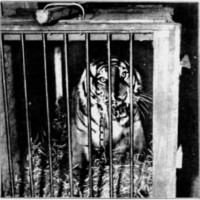Top 10 Interesting Facts About Bengal Tigers
Given the prolific amount of knowledge I have of zoology - crowding about ten years or more - I've decided to segway into zoology for a while, although I do have other, frankly better ideas, but the research phase for those feels... different from doing research on various animals, I'm hoping to eventually get to these other ones. In the meantime, here are some facts about the planet's biggest cat.
It's a common belief, and an honest mistake, to think that White tigers are a different subspecies but surprisingly white tigers are Bengal tigers. Their black and white colouring, in lieu of red, black and orange, is caused by genetic mutation that only occurs in about one out of every ten thousand tigers.
This means that two orange Bengal tigers can have a white tiger cub, although as the statistics show, it is literally one in a thousand. But white tigers have not been seen in the wild since the 1950s, so we have to suspect that white tigers are only seen in private places. While I find this as a rather stupid clause, for whatever the reason may be, it is illegal to breed tigers in an attempt to get that one out of a thousand cub which is a white tiger to breed more white tigers.

If you find this surprising, well, let's compare what happens when you try to bathe your typical house cat, for some perspective. When you try to give your pet cat a bath, even if it is very deserving, the cat reacts what lots of thrashing, clawing, and meowing, so it feels like a minor miracle to get the damn cat into the tub. So forget about it being a good swimmer. On the flipside, Bengal tigers actually love the water and have an impressive swimming capabilities.They can swim just short of four miles per hour. Bengal tigers usually jump in rivers or lakes to cool off, but will go for a swim in order to pursue prey as needed. But, like any species out there, the Bengal can't go for a dip without being contested. Usually they're met with some territorial disputes from crocodiles.

Unlike most other big cats out there, a Bengal tiger's roar, generally speaking, is not out of aggression. With the occasional exception, of course. Bengal tigers only roar in order to communicate with other tigers which live outside of their territory, as if to say, "Hey you! You are getting close to my territory!" or something to that effect.
If a Bengal tiger is on the hunt, pursuing prey, or fighting other tigers over a territorial dispute, it will typically make a purring noise, but unlike that of a domestic cat, it sounds pretty sinister coming from the runner up for King of the Jungle. When a Bengal tiger makes that purring noise, it is more often than not, loud and menacing, that it is wrongly mistaken for a growl.

This might be surprising, or even upsetting to true animal lovers, given how rare Bengal tigers already are, these days. But the Bengal tiger is a unique specimen in this area. Bengal tigers can reproduce, which I hope is no surprise whatsoever given they are not extinct. But while most mammals are fertile, or ready to reproduce for a good chunk of the year, a female Bengal tiger is only fertile for less than one week out of an entire year, so the mating process might be a high risk, low reward period of time. If the female Bengal tiger indeed achieves conception, or the period of pregnancy lasts a little longer than 100 days, and most litters consist of four cubs at the most. They leave the mother around when they're two, and they're considered adults, or close to adults. And from a statistical standpoint, the likelihood that this cub will be able to reproduce is very slim. Definitely one of the more sad facts.

For the most part, that is the case for big cats. Including cheetahs. While we might assume that cats like Bengal tigers and cheetahs are marathoners, that is not the case. Canines are the marathoners. Anyway, Bengal tigers can run as fast as 40 miles per hour, but only for short distances. Which by definition, means they're sprinters. This is why they rely on more so on a stealth hunting approach than one that requires the pursuit of prey for long distances. This lets Bengals spend the necessary resting and regaining stamina. Much like your typical house cat, Bengals have paws that are padded. This allows them to push themselves in speed while in motion. And on top of that, they are fast but bulky in size. Nature is fascinating, folks.

Often times, when humans are afraid of certain creatures, our first thought is to demonize them and make the assumption that these animals aren't afraid of us. In reality, Bengals will do whatever it takes to stay away from humans. Unfortunately for the Bengal tiger, it is is becoming increasingly difficult to avoid humans due to villages, mainly in India, increasing in size, forcing the habitat of the Bengal and towns to come closer and closer together, due to urbanization. Not so long ago, I'm sure it was much scarier for the Bengals in the wild. Not because of urbanization, mind you, but because they only became an endangered species in 2008. Prior to that, they were mercilessly hunted for their skin used for clothes, and taxidermy, I'm sure.

All tigers are supposedly the kids of Sabre tooth tigers from the Ice Ages. I disagree with darwinism, but for the sake of argument, or a lack thereof, I'll put that aside. Back to the point, the teeth of Sabre tooth tigers are huge, to the extent that their breed name literally meant "sword tooth tiger". Bengal tigers don't have the same tooth length as the Sabre tooth tigers, by a long shot, but the teeth of a Bengal are just as vital to survival as those of their ancestor. If not more. Bengals need their teeth not just to eat their well earned meal, but to kill their prey, and they probably use their teeth to fight over territory, or possibly a mate. Should a Bengal lose his or her teeth in, for instance a fight, they would be crippled regarding their newfound inability to hunt and would probably die from starvation. Unlike humans, who can survive over a month without food, a Bengal tiger can only survive a few of weeks without eating, and don't expect them to look to plants as a source of food.
Okay, before I get started, I'll say that it's disappointing that some animals are more chivalrous than humans. With that said, although Bengal tigers usually hunt by themselves, as opposed to hunting with a pride, like lions do, as they are typically loners, but if cubs are a factor to consider, the eating process is not what you'd expect it to be. A male Bengal will let his cubs and his mate eat from what he killed for them before eating part of the meal himself.
Let's do another comparison with lions for emphasis. The male lion will always eat before the rest of his pride, as a form of showing dominance, despite the females usually are the ones who take down their prey. I wouldn't be surprised if you assumed that Bengals did likewise, given how lions set the stage for other wild cats in many ways.

Buckle up. This one is a roller coaster of a narrative. Bengal tigers among the first animals to be taught to do certain tricks in circus performances. Bengals are trained to follow their circus trainer's instructions, in order for them to be taught to jump through hoops, climb ladders or anything else they can do to amaze the audience. But this is not pure fun. In the past few years, Bengal tiger tricks have gotten a different perspective than just what the audience sees. The tigers are treated horribly by the circus, and travel in cramped cages, and are even chained.
To top that off, their trainers use whips and shockers as ways to get tigers to do tricks. But, the abuse has come to a halt. A present day circus needs to have permits to let them keep Bengal tigers, much less teach them tricks. Definitely one of the more sad ones out there.

If you look at a Bengal tiger in a zoo, you might see it licking its fur, like a domestic house cat does. You may think they do this to simply clean themselves, and as far as ones in captivity go, there's a better chance that you're right than if you were to see one in the wild. But a more peculiar Bengal tiger fact is that this is a defense mechanism against infection. A Bengal tiger's saliva has natural antiseptic components that can stop their wounds from becoming infected. These components can also cause the tiger's wounds to heal faster. This is vital due to the talking points I made previously over how Bengals can be harmed when fighting over territory or when it is hunting. So, if a Bengal tiger is injured in either scenario, no worries. Their saliva has them covered. In a literal sense. Like a built in first aid kit. Isn't that a nice fact to end this list with?